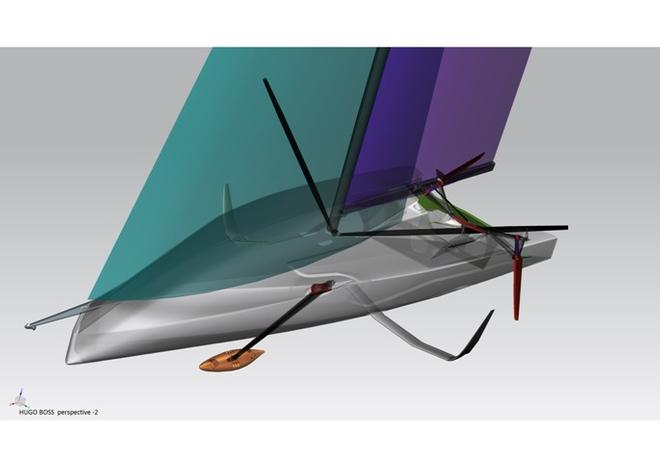America's Cup - Emirates Team New Zealand confirm monohull for Cup
by Richard Gladwell, Sail-World NZ on 11 Sep 2017

The America's Cup Class is expected to use similar foil systems to the IMOCA60 class. However there is no reference point for a round the buoys foiling monohull. Guillaume Verdier
Following comments attributed to Luna Rossa principal, Patrizio Bertelli, Emirates Team New Zealand have confirmed that the next America's Cup will be sailed a high performance monohull yacht.
A statement issued by the team this evening (NZT) reads:
Emirates Team New Zealand can confirm Patrizio Bertelli’s suggestion today that the next America’s Cup will be sailed in high performance monohull yachts.
Currently there are a team of designers, lead by Emirates Team New Zealand Design Coordinator Dan Bernasconi working on various exciting monohull concepts which will eventually help shape the AC36 Class Rule.
Emirates Team New Zealand have been consulting with a number of potential challengers and there is an overall desire to have a spectacular monohull yacht that will be exciting to match race, but also one that the public and sailors can relate to as a sail boat that really challenges a full crew of professional yachtsman around the race track.
Further details of the Protocol for the 36th America’s Cup will be announced at the end of the month.
Update the day after:
News of the shift to a monohull drew a very mixed response, mainly split into two camps - those who had seen the AC50's racing on the water in Bermuda, and those who had only seen them on TV. The latter group believed the shift to the monohull was a sound move. The former, along with multihull sailing fans believed the move was a retrograde step.
It is unclear as to what is being developed, with some expecting to see a similar approach to that taken, rightly or wrongly, with the AC50 and substantial parts of the class being one design and constructed using tooling that was common and made available to all teams/builders.
The reality is that a class rule similar to that for the International America's Cup Class would appear to be developed.
That is in reality a 'box rule' which attempts to put some constraint on hull shape. However the outcome of that process is that in the first cycle, the boats will vary widely in design, increasingly moving into the same corner of the rule , where after several Cup cycles the differences between the boats are infinitesimal.
The IACC class rule ran to five versions before the class was discarded after the 2007 America's Cup having been in vogue for five America's Cup cycles. The boat developed into a type that was extremely impressive sailing to windward, but had the performance that could be matched by a 45-50fter downwind.
If a one design is not produced, then it is likely that each team will have to be allowed to build two boats - allowing the chance for the first to be a design dud, and for the team not to be stuck with that boat for the Cup.
It is not known if the design will be capable of foiling upwind. The Mirabaud 18ft skiff in the video above was one attempt to produce a monohulled foiler that would sail upwind. The R-class below from New Zealand are 12ft skiffs. Both get their required righting moment from crew weight and not lead weight.
Many quote the example of the IMOCA60, however these are not designed for inshore round the buoys racing - but long trans-oceanic races where the course can be optimised for the prevailing and expected weather to sail fast with eased sheets.
The other issue with the production of a new rule in the America's Cup is that of unintended consequences, which often make for a very one sided contest.
In 1992 - the first year of the IACC rule, Bill Koch's America3 team, built four of the new IACC boats, found that the narrowest was fastest, and raced that prevailing by 4-1 over Il Moro di Venezia (ITA), who built five IACC hulls before settling on their race boat. Most of the other teams opted for a more conventional wider beamed boat.
In the first rendition of the AC72 in the 2013 America's Cup, Emirates Team New Zealand produced a foiling catamaran, when everyone else expected the boats to be displacement only.
If you want to link to this article then please use this URL: www.sail-world.com/157155